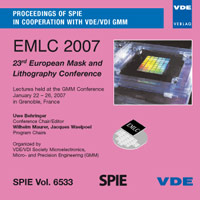Production Evaluation of Automated Reticle Defect Printability Prediction Application
Konferenz: EMLC 2007 - 23rd European Mask and Lithography Conference
22.01.2007 - 26.01.2007 in Grenoble, France
Tagungsband: EMLC 2007
Seiten: 7Sprache: EnglischTyp: PDF
Persönliche VDE-Mitglieder erhalten auf diesen Artikel 10% Rabatt
Autoren:
Howard, William B.; Pomeroy, Scott (KLA-Tencor, 8834 N. Capital of Texas Highway, Suite 301, Austin, TX 78759 USA)
Moses, Raphael; Thaler, Thomas (Advanced Mask Technology Center, Rähnitzer Allee 9, 01109 Dresden, Germany)
Inhalt:
The growing complexity of reticles and continual tightening of defect specifications causes the reticle defect disposition function to become increasingly difficult. No longer can defect specifications be distilled to a single number, nor can past simple classification rules be employed due to the effects of MEEF on actual printing behavior. The mask maker now requires lithography-based rules and capabilities for making these go/no-go decisions at the reticle inspection step. We have evaluated an automated system that predicts the lithographic significance of reticle defects using PROLITH(TM) technology. This printability prediction tool was evaluated and tested in a production environment using both standard test reticles and production samples in an advanced reticle manufacturing environment. Reference measurements on Zeiss AIMS(TM) systems were used to assess the accuracy of predicted results. The application, called the Automated Mask Defect Disposition System, or AMDD, models defective and non-defective test and reference images generated by a high-resolution inspection system. The results were calculated according to the wafer exposure conditions given at setup such that the reticle could be judged for its ‘fitness-for-use’ from a lithographic standpoint rather than from a simple physical measurement of the film materials. We present the methods and empirical results comparing 1D and 2D Intensity Difference Metrics (IDMs) with respect to AIMS and discuss the results of usability and productivity studies as they apply to manufacturing environments.


